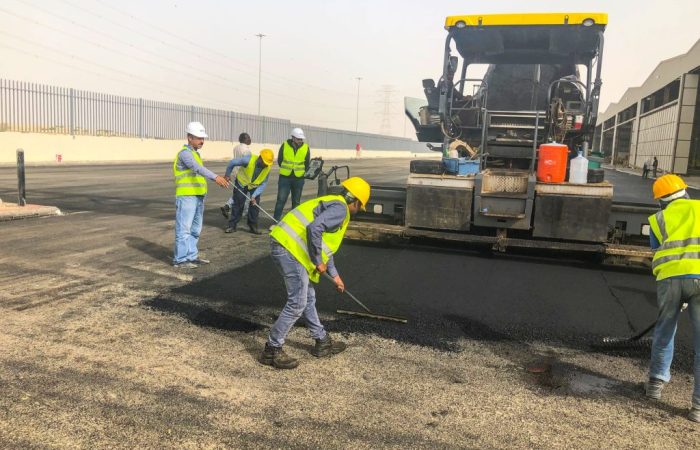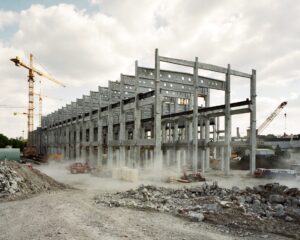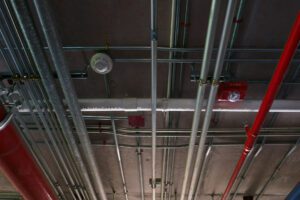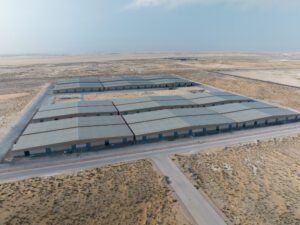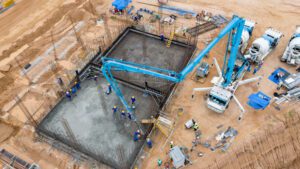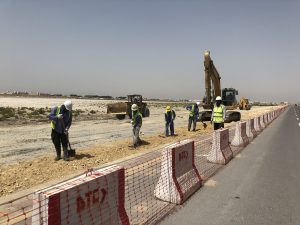Road Construction
Road construction services are an important part of any development projects. Whether you’re building a new road or repairing an existing one, it’s critical to choose the right road construction services provider. In this blog post, we will take a look at some of the key considerations when hiring a road construction service provider, as well as what types of services they offer. From understanding your local laws and regulations to determining the best equipment for your project, learn more about how you can ensure your road construction project is completed safely and efficiently.
Retexturing
Retexturing is the process of adding a new layer of asphalt to an existing roadway. This can be done for a number of reasons, including to improve the appearance of the road, to add extra protection against weathering, or to repair damage that has been done to the original surface.
The first step in retexturing a road is to clean off the existing surface. This can be done with a power washer or by manually scrubbing the surface with brushes. Once the surface is clean, a new layer of asphalt is added. The thickness of this layer will depend on the condition of the original surface and the desired results.
After the new asphalt has been added, it will need to be compacted. This can be done with heavy machinery or by rolling vehicles back and forth over the new surface. Once compacted, the road will be ready for use.
concrete road cutting
Most concrete roadways are cut with a power saw. The blade is mounted on a large, diesel-powered machine and operated by a trained operator. The operator starts the cut at one end of the roadway and progresses down the length of the roadway, cutting through the concrete and any rebar reinforcement that may be present.
After the concrete has been cut, it is removed from the roadway by another machine, called a skid steer loader or Bobcat. Theloader picks up the large pieces of concrete and loads them into a dump truck. The dump truck then takes the concrete to a landfill or other disposal facility.
The cutting of concrete roadways is a noisy process and can create a lot of dust. Because of this, it is important for operators to use proper safety equipment, including earplugs or headphones to protect their hearing, and dust masks to protect their lungs.
QPC Full Depth Cutting
The Queensland Pavement Consortium (QPC) is a full depth pavement cutting specialist. We have been operating in South East Queensland since 2004.
We provide a comprehensive service for all types of pavement cutting, from small domestic jobs through to large commercial and industrial projects.
Our services include:
– Concrete Cutting
– Asphalt Cutting
– Kerb & Channel Cutting
– Core Drilling
– Wall Sawing
– Wire Sawing
Concrete Cutting
There are many reasons why you might need concrete cutting services. Maybe you’re doing some road construction and need to cut through existing concrete. Or, you might be demolishing an old building and need to remove the concrete foundation. Whatever the reason, there are a few things you should know about concrete cutting before you hire a contractor.
First, it’s important to understand the difference between wet and dry cutting. Wet cutting is when water is used to cool the blade and minimise dust. Dry cutting, on the other hand, doesn’t use water but produces more dust. If you’re doing a large job, wet cutting is generally the better option because it’s less messy and creates less dust.
Next, you’ll need to choose the right type of blade for your project. There are many different types of blades available, each designed for a specific type of material. For example, there are diamond blades that are designed specifically for cutting concrete. If you’re not sure which type of blade to use, your contractor should be able to help you choose the right one.
Finally, make sure you have all the necessary safety equipment before starting your project. Cutting concrete can produce a lot of dust, so it’s important to wear a respirator or face mask to protect yourself. You’ll also need gloves and eye protection to keep yourself safe from flying debris. Once you have all your safety gear in place, you’re ready to start cutting concrete!
PQC Cutting
Asphalt pavement is one of the most widely used materials for road construction. It is composed of a mixture of aggregate (crushed stone, gravel, and sand) and asphalt binder. The asphalt binder is a petroleum product that binds the other ingredients together and gives the pavement its black color.
PQC cutting is a method of cutting asphalt pavement that uses a diamond-tipped blade. The blade is mounted on a machine that cuts through the pavement like a saw. PQC cutting is often used to repair damaged pavements or to create expansion joints.
Sealant Application Service
Our sealant application service is second to none. We use only the highest quality materials and our experienced staff will ensure that your job is done right the first time. We can provide a variety of services including:
-Seal coating
-Crack Filling
-Pothole Repair
-Line Striping
We know that when it comes to your pavement, you want it to look its best. That’s why we offer a wide range of services to keep your pavement looking great all year round. Contact us today to learn more about our sealant application service.
Back-Up Rods
Back-Up Rods
If you’re planning on doing any road construction, it’s important to have a back-up plan in place in case something goes wrong. Back-up rods are an essential part of this plan. They are used to support the structure of the road and help keep it stable during construction.
There are various types of back-up rods available on the market, so it’s important to choose the right one for your project. For example, if you’re working with a concrete road, you’ll need a different type of back-up rod than if you’re working with an asphalt road.
Some factors to consider when choosing back-up rods include:
– The type of material the road is made from
– The weight of the materials being used in construction
– The amount of traffic that will be using the road once it’s completed
Once you’ve chosen the right back-up rod for your project, be sure to follow the manufacturer’s instructions carefully to ensure proper installation. With a little planning and preparation, back-up rods can help make your road construction project a success.
Polysulphide Sealant Application
Polysulphide sealant is a type of cold applied sealant that is commonly used in road construction. It is a two-part system that consists of a base and an activator. The base is a polymer blend of sulphur and polysulphide, while the activator is a liquid or paste that contains active ingredients such as zinc oxide.
When mixed together, these two components react to form a cross-linked polymer that is highly resistant to water and chemicals. This makes it ideal for use in sealing cracks and joints in concrete surfaces. Polysulphide sealants are also often used to waterproof tunnels, reservoirs, and other underground structures.
Application of polysulphide sealant is relatively simple. First, the base and activator are mixed together in the desired ratio. Next, the mixture is applied to the surface using a brush, roller, or sprayer. Once the sealant has been applied, it will need to cure for several hours or days before it reaches its full strength.
Groove Cleaning
Road construction crews will oftentimes need to clean out existing grooves in order to prepare the road for resurfacing. Groove cleaning is a time-consuming process, but it is crucial for ensuring a smooth, even surface.
The first step in groove cleaning is to use a high-pressure hose to remove any debris or build-up from the groove. This will help to loosen any dirt or grime that may be stuck to the sides of the groove. Next, a rotary brush attached to a power washer can be used to scrub the sides of the groove.
Once the sides of the groove have been thoroughly cleaned, a vacuum truck can be used to suction out any remaining dirt or water. Finally, a blow torch can be used to dry out the groove and prepare it for resurfacing.
Polyurethane Sealant Application
Polyurethane sealants are a type of high-performance sealant that are commonly used in road construction projects. There are many benefits to using polyurethane sealants, including their ability to resist weathering, UV rays, and chemicals. Polyurethane sealants are also very flexible, which makes them ideal for use in areas that experience a lot of movement or vibration.
To apply polyurethane sealant, first make sure the surface is clean and dry. Next, apply a bead of sealant around the perimeter of the area you wish to seal. For best results, use a caulking gun to apply the sealant evenly. Once the bead of sealant is in place, use a putty knife or another type of tool to smooth it out so that it is level with the surface. Allow the sealant to cure for 24 hours before subjecting it to any traffic or other wear and tear.
Highways
The highways in the United States are some of the busiest roads in the world. Every day, millions of Americans use these roads to commute to work, go to school, or run errands. With so much traffic, it’s no wonder that highway construction is a booming industry.
There are many different types of highway construction projects, from small repairs to complete rebuilds. Whatever the scope of the project, there are certain steps that must be followed in order to ensure a safe and successful outcome.
First, a thorough analysis of the existing road is conducted in order to identify any potential problems. Once the problem areas have been identified, a plan is created to address them. This plan includes things like detours, lane closures, and estimated timelines.
Once the plan is in place, construction can begin. This typically involves excavating the existing roadway and laying down new pavement. Depending on the severity of the damage, this process can take anywhere from a few days to several months.
Once the new highway has been built, it must be tested before it can be opened to traffic. This testing ensures that everything was done correctly and that the new road is safe for drivers. Only after passing this final test can a highway be opened to the public.
Expressways
An expressway is a high-speed, limited-access highway that is designed for fast and safe travel. Expressways typically have multiple lanes in each direction and are divided by a median strip or barrier. They may also have grade-separated interchanges with other highways and roads.
Expressways are built to accommodate the higher speeds and increased traffic volumes of modern life. They can help reduce congestion on crowded city streets and make long-distance travel faster and easier. Expressways can also improve safety by separating local traffic from through traffic, and by providing more direct routes that are less likely to have accidents.
Building an expressway is a major undertaking that requires careful planning and execution. The first step is to conduct a feasibility study to determine the need for an expressway and its potential impacts. If the study shows that an expressway is needed, the next step is to acquire the necessary land and obtain all the necessary approvals from government agencies.
Once the project has been approved, construction can begin. Building an expressway typically involves constructing new bridges, widening existing roads, and grading new roadway slopes. The work must be carefully coordinated to minimize traffic disruptions during construction.
City internal roads
The City of Toronto is responsible for the maintenance and repair of all city-owned roads and sidewalks. The City’s Road Operations Division is responsible for clearing snow and ice from city streets, as well as repairing potholes and other road surface defects.
In addition to maintaining existing roads, the City is also responsible for constructing new roads to accommodate growth and development. The Construction Services Section of the Road Operations Division is responsible for designing and oversee the construction of new roadways, as well as coordinating construction activities with other City divisions and outside agencies.
Concrete roads
Concrete roads are the most common type of road in the United States. They are also the most durable, long-lasting kind of road. Concrete roads can last up to 30 years with proper maintenance.
Airports
Construction companies are often responsible for building and maintaining airports. This can include everything from the initial construction of the facility to routine maintenance tasks. Some construction companies may specialise in airport construction, while others may have a more general focus.
When constructing an airport, there are a number of considerations that must be taken into account. The most important factor is usually the safety of passengers and workers. Construction companies must adhere to strict safety standards when working on airport projects.
In addition to safety, another key consideration in airport construction is efficiency. Airports must be able to handle large volumes of traffic without delays. Construction companies must therefore carefully plan and execute every aspect of the project to ensure that the finished product meets these requirements.
Quality is also important in airport construction. Airports are expensive facilities, and their owners expect them to last for many years. Construction companies must use high-quality materials and craftsmanship in order to meet these expectations.
If you’re interested in working on airport construction projects, you’ll need to have experience in the construction industry. Many airports are owned by government entities, so it’s also helpful to have some understanding of government contracting processes.

